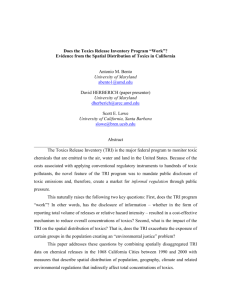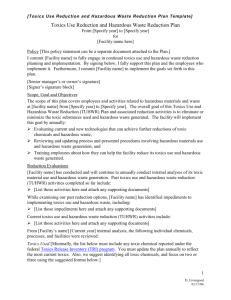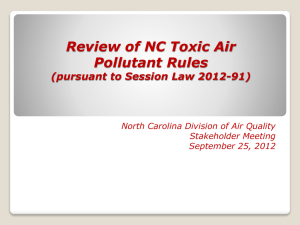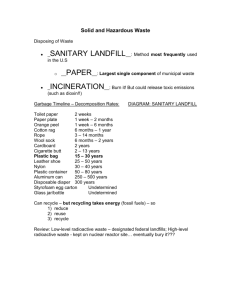REDUCTION OF USE OF TOXIC SUBSTANCES AND HAZARDOUS
advertisement
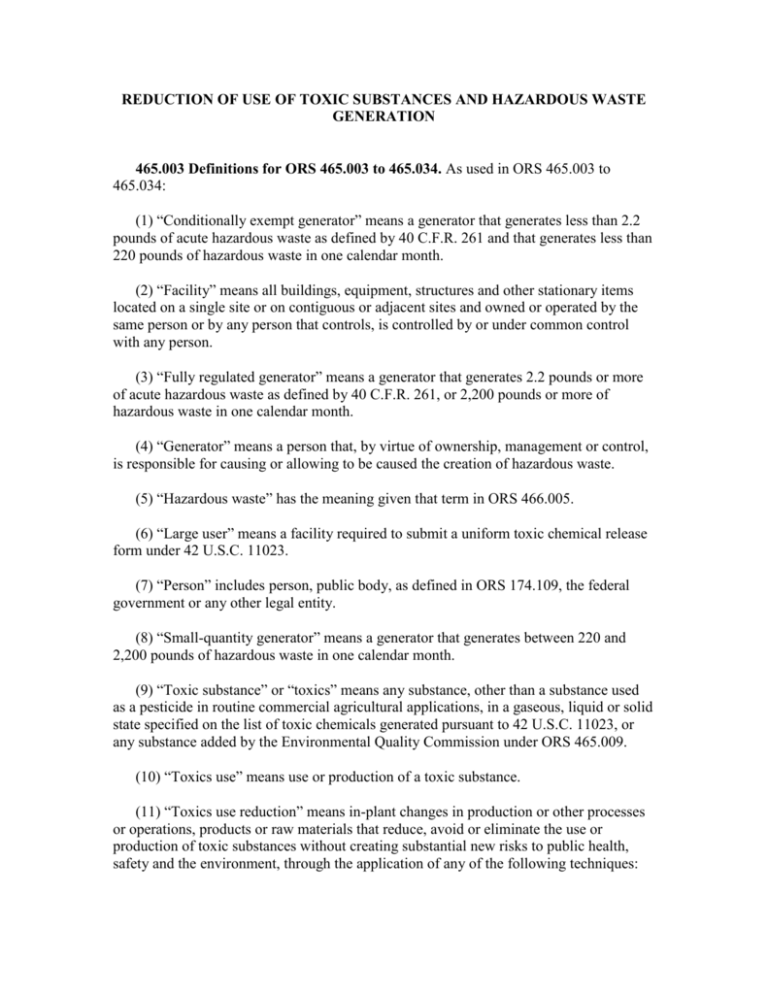
REDUCTION OF USE OF TOXIC SUBSTANCES AND HAZARDOUS WASTE GENERATION 465.003 Definitions for ORS 465.003 to 465.034. As used in ORS 465.003 to 465.034: (1) “Conditionally exempt generator” means a generator that generates less than 2.2 pounds of acute hazardous waste as defined by 40 C.F.R. 261 and that generates less than 220 pounds of hazardous waste in one calendar month. (2) “Facility” means all buildings, equipment, structures and other stationary items located on a single site or on contiguous or adjacent sites and owned or operated by the same person or by any person that controls, is controlled by or under common control with any person. (3) “Fully regulated generator” means a generator that generates 2.2 pounds or more of acute hazardous waste as defined by 40 C.F.R. 261, or 2,200 pounds or more of hazardous waste in one calendar month. (4) “Generator” means a person that, by virtue of ownership, management or control, is responsible for causing or allowing to be caused the creation of hazardous waste. (5) “Hazardous waste” has the meaning given that term in ORS 466.005. (6) “Large user” means a facility required to submit a uniform toxic chemical release form under 42 U.S.C. 11023. (7) “Person” includes person, public body, as defined in ORS 174.109, the federal government or any other legal entity. (8) “Small-quantity generator” means a generator that generates between 220 and 2,200 pounds of hazardous waste in one calendar month. (9) “Toxic substance” or “toxics” means any substance, other than a substance used as a pesticide in routine commercial agricultural applications, in a gaseous, liquid or solid state specified on the list of toxic chemicals generated pursuant to 42 U.S.C. 11023, or any substance added by the Environmental Quality Commission under ORS 465.009. (10) “Toxics use” means use or production of a toxic substance. (11) “Toxics use reduction” means in-plant changes in production or other processes or operations, products or raw materials that reduce, avoid or eliminate the use or production of toxic substances without creating substantial new risks to public health, safety and the environment, through the application of any of the following techniques: (a) Input substitution, achieved by replacing a toxic substance or raw material used in a production or other process or operation with a nontoxic or less toxic substance; (b) Product reformulation, achieved by substituting for an existing end product, an end product that is nontoxic or less toxic upon use, release or disposal; (c) Production or other process or operation redesign or modifications; (d) Production or other process or operation modernization, achieved by upgrading or replacing existing equipment and methods with other equipment and methods; (e) Improved operation and maintenance controls of production or other process or operation equipment and methods, achieved by modifying or adding to existing equipment or methods including, but not limited to, techniques such as improved housekeeping practices, system adjustments, product and process inspections or production or other process or operation control equipment or methods; or (f) Recycling, reuse or extended use of toxics by using equipment or methods that become an integral part of the production or other process or operation of concern, including but not limited to filtration and other methods. (12) “Toxics user” means a large user, a fully regulated generator or a small-quantity generator. (13) “Waste reduction” means: (a) Any activity conducted after hazardous waste is generated that is consistent with the general goal of reducing present and future threats to public health, safety and the environment and that results in: (A) The reduction of total volume or quantity of hazardous waste generated that would otherwise be treated, stored or disposed of; (B) The reduction of toxicity of hazardous waste that would otherwise be treated, stored or disposed of; or (C) Both the reduction of total volume or quantity and the reduction of toxicity of hazardous waste. (b) On-site or off-site treatment where the treatment can be shown to confer a higher degree of protection of the public health, safety and the environment than other technically and economically practicable waste reduction alternatives. [1989 c.833 §2; 2005 c.206 §3] 465.006 Policy. (1) In the interest of protecting the public health, safety and the environment, the Legislative Assembly declares that it is the policy of the State of Oregon to encourage reduction in the use of toxic substances and to reduce the generation of hazardous waste whenever technically and economically practicable, without shifting risks from one part of a process, environmental media or product to another. Priority shall be given to methods that reduce the amount of toxics used and, where that is not technically and economically practicable, methods that reduce the generation of hazardous waste. (2) The Legislative Assembly finds that the best means to achieve the policy set forth in subsection (1) of this section is by: (a) Providing toxics users and generators with technical assistance; (b) Requiring toxics users to engage in comprehensive planning and develop measurable performance goals; and (c) Monitoring the use of toxic substances and the generation of hazardous waste. [1989 c.833 §3] 465.009 Rules. The Environmental Quality Commission by rule may: (1) Add or remove any toxic substance or hazardous waste from the provisions of ORS 465.003 to 465.034; and (2) Modify the definition of “large user” to coincide with the amounts specified in federal regulations for the reporting of toxic chemical releases. [1989 c.833 §4; 2005 c.206 §4] 465.010 [Amended by 1971 c.743 §371; repealed by 1989 c.846 §15] 465.012 Technical assistance to users and generators; priority; restrictions on enforcement resulting from technical assistance; rules. (1) The Department of Environmental Quality shall provide technical assistance to toxics users and conditionally exempt generators. In identifying the users and generators to which the department shall give priority in providing technical assistance, the department shall consider at least the following: (a) Amounts and toxicity of toxics used and amounts of hazardous waste disposed of, discharged and released; (b) Potential for current and future toxics use reduction and hazardous waste reduction; and (c) The toxics related exposures and risks posed to public health, safety and the environment. (2) In providing technical assistance, the department shall give priority to assisting toxics users and conditionally exempt generators in completing and implementing an adequate toxics use reduction and hazardous waste reduction plan under ORS 465.015. The assistance may include but need not be limited to: (a) Information clearinghouse activities; (b) Telephone hotline assistance; (c) Toxics use reduction and hazardous waste reduction training workshops; (d) Establishing a technical publications library; (e) The development of a system to evaluate the effectiveness of toxics use reduction and hazardous waste reduction measures; (f) The development of a recognition program to publicly acknowledge toxics users and conditionally exempt generators that complete and implement successful toxics use reduction and hazardous waste reduction plans; and (g) Direct on-site assistance to toxics users and conditionally exempt generators in completing the plans. (3) The department shall: (a) Coordinate its technical assistance efforts with industry trade associations and local colleges and universities as appropriate. (b) Follow up with toxics users that receive technical assistance to determine whether the user or generator implemented a toxics use reduction and hazardous waste reduction plan. (c) Coordinate and work with local agencies to provide technical assistance to businesses involved in the crushing of motor vehicles concerning the safe removal and proper disposal of mercury light switches from motor vehicles. (4) Technical assistance services provided under this section shall not result in inspections or other enforcement actions unless there is reasonable cause to believe there exists a clear and immediate danger to the public health and safety or to the environment. The Environmental Quality Commission may develop rules to carry out the intent of this subsection. [1989 c.833 §5; 2001 c.924 §9; 2005 c.206 §5] 465.015 Toxics use and hazardous waste reduction plan required; composition; exemption; retention at facility. (1) Except as provided in subsection (2) of this section, a person shall, within 120 days after notification in writing by the Department of Environmental Quality that the person meets the definition of a toxics user, complete a toxics use reduction and hazardous waste reduction plan. At a minimum, a plan shall include: (a) A written policy articulating organizational support for the toxics use reduction and hazardous waste reduction plan and a commitment by the organization to implement plan goals. (b) A description of its scope and objectives, including the evaluation of technologies, procedures and personnel training programs to ensure unnecessary toxic substances are not used and unnecessary waste is not generated. (c) Internal analysis and periodic assessment of individual processes for toxics use and hazardous waste generation. (d) Identification of opportunities to reduce or eliminate toxics use and hazardous waste generation. (e) Employee awareness and training programs that involve employees in toxics use reduction and hazardous waste reduction planning and implementation. (f) Institutionalization of the plan by incorporating the plan into management practices and procedures. (2) A person is not required to complete a plan if the person has implemented an environmental management system, as defined in ORS 468.172. (3) A toxics user shall incorporate into the plan and associated decision-making process, the costs of using toxic substances and generating hazardous waste. The costs may represent, among other things, the costs of management, liability insurance, regulatory compliance and oversight. (4) As part of each plan, a toxics user shall evaluate technically and economically practicable toxics use reduction and hazardous waste reduction opportunities for: (a) Any toxic substance for which the toxics user reports as a large user; and (b) Any hazardous waste representing 10 percent or more by weight of the cumulative hazardous waste stream generated per year. (5) A toxics user shall explain the rationale for each toxics use reduction and waste reduction opportunity specified in the plan, including any impediments, such as technical or economic barriers, to toxics use reduction and hazardous waste reduction. (6) A toxics use reduction and hazardous waste reduction plan developed under this section or the documentation for an environmental management system shall be retained at the facility. To the extent that a plan or system may be considered a public record under ORS 192.410, the information contained in the plan or system is confidential and is exempt from public disclosure pursuant to ORS 192.502. (7) It is the policy of this state that plans developed under this section be kept current and that the plans reflect changes in toxics use over time. In furtherance of this policy, a toxics user may update its plan or modify its environmental management system to reflect any changes. [1989 c.833 §7; 1997 c.384 §1; 2005 c.206 §6] 465.018 Notification of Department of Environmental Quality upon completion of plan or system; implementation summary required; inspection of plan or system. (1) Following completion of a toxics use reduction and hazardous waste reduction plan under ORS 465.015 or implementation of an environmental management system, a toxics user shall notify the Department of Environmental Quality in a form determined by the department that the plan or system is in place. (2) Twelve months after notifying the department under subsection (1) of this section, the toxics user shall provide an implementation summary to the department. (3) Twenty-four months after notifying the department under subsection (1) of this section, the toxics user shall provide a second implementation summary to the department. (4) A toxics user shall permit the Director of the Department of Environmental Quality or the director’s designee to inspect a plan or system to allow the department to: (a) Determine the adequacy of the plan or system under ORS 465.021; (b) Assess the implementation of the plan or system; and (c) Provide technical assistance under ORS 465.012. (5) The department shall make implementation summaries submitted to the department under this section available to the public, including making the summaries available in a commonly used, electronic format on the World Wide Web. [1989 c.833 §8; 2005 c.206 §7] 465.020 [Amended by 1979 c.284 §151; repealed by 1989 c.846 §15] 465.021 Review of plan or system; notification of inadequacies in plan, system or summary; revisions; penalty. (1) The Department of Environmental Quality may review and determine the adequacy of a toxics use reduction and hazardous waste reduction plan or an environmental management system. (2) If a toxics user fails to complete an adequate plan, implement an adequate system or submit an adequate implementation summary, the department may notify the toxics user of the inadequacy, identifying the specific deficiencies. The department also may specify a reasonable time frame, of not less than 90 days, within which the toxics user shall modify the plan, system or implementation summary to address the specified deficiencies. The department also may make technical assistance available to aid the toxics user in modifying its plan, system or implementation summary. (3) If the department determines that a modified plan, system or implementation summary is inadequate, the department may require that further modifications be made within a time frame specified by the department. (4) If after having received notice of specified deficiencies from the department, a toxics user fails to develop an adequate plan, system or summary within a time frame specified pursuant to subsection (2) or (3) of this section, the department may assess a civil penalty in the manner provided by ORS 183.745 in an amount not to exceed $500 for each day that the toxics user fails to develop an adequate plan, system or summary. (5) In reviewing the adequacy of any plan, system or summary, the department shall base its determination solely on whether the plan, system or summary is complete and prepared in accordance with ORS 465.015 or 465.032. [1989 c.833 §9; 2005 c.206 §8] 465.024 [1989 c.833 §10; 1997 c.384 §2; repealed by 2005 c.206 §11] 465.027 Contract for assistance with higher education institution. Subject to available funding, the Department of Environmental Quality shall contract with an established institution of higher education to assist the department in carrying out the provisions of ORS 465.003 to 465.034. The assistance shall emphasize strategies to encourage toxics use reduction and hazardous waste reduction and shall provide assistance to facilities under ORS 465.003 to 465.034. The assistance may include but need not be limited to: (1) Engineering internships; (2) Engineering curriculum development; (3) Applied toxics use reduction and hazardous waste reduction research; and (4) Engineering assistance to users and generators. [1989 c.833 §12] 465.030 [Repealed by 1989 c.846 §15] 465.031 [1989 c.833 §14; repealed by 2005 c.206 §11] 465.032 Form of implementation summary; information required. An implementation summary submitted to the Department of Environmental Quality under ORS 465.018 shall be in a form determined by the department and shall include, but not be limited to: (1) A summary of how the toxics use reduction and hazardous waste reduction plan or environmental management system has been implemented; (2) A description of specific successes that the toxics user has had in reducing the use of toxic substances or the generation of hazardous wastes; (3) An estimate of the challenges and impediments to implementing and evaluating toxics use reduction and hazardous waste reduction opportunities; and (4) A description of future plans for toxics use reduction and hazardous waste reduction. [2005 c.206 §2] 465.034 Application of ORS 465.003 to 465.034. Notwithstanding any provision of ORS 465.003 to 465.034, nothing in ORS 465.003 to 465.034 applies to: (1) Hazardous wastes generated from a removal, as defined in ORS 465.200, or from a one-time event. (2) A raw material that contains a naturally occurring toxic substance and that is used in a process for which there is no substitute. [1989 c.833 §16; 2005 c.206 §9] 465.037 Short title. ORS 465.003 to 465.034 shall be known as the Toxics Use Reduction and Hazardous Waste Reduction Act. [1989 c.833 §1] 465.040 [Amended by 1971 c.743 §372; repealed by 1989 c.846 §15] 465.050 [Amended by 1971 c.743 §373; repealed by 1989 c.846 §15] 465.060 [Repealed by 1989 c.846 §15] 465.070 [1989 Repealed by 1989 c.846 §15] 465.090 [Amended by 1971 c.743 §374; repealed by 1989 c.846 §15] 465.100 [1977 c.850 §2; 1985 c.728 §83; 1987 c.914 §26; renumbered 464.430 in 1987]
